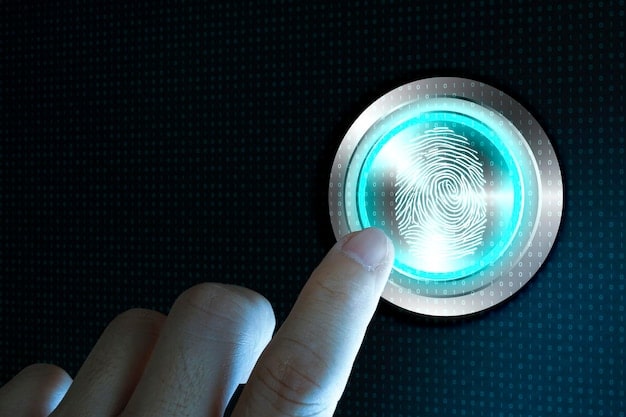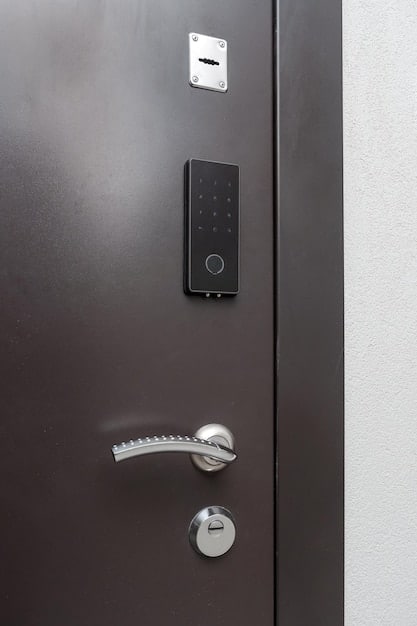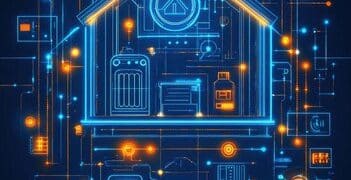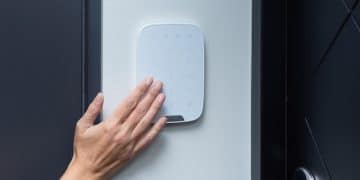Biometric Locks: The Future of Smart Home Security in 2025?

Smart Home Security Trends: Are Biometric Locks the New Standard by Mid-2025? Biometric locks, utilizing unique biological traits for access, are rapidly gaining traction in smart homes, potentially becoming the standard for enhanced security by 2025, offering unparalleled convenience and protection against traditional security vulnerabilities.
Imagine unlocking your front door with just a touch, your fingerprint granting entry to your safe haven. The realm of smart home security is rapidly evolving, and one technology, in particular, is poised to revolutionize how we protect our homes. Are **Smart Home Security Trends: Are Biometric Locks the New Standard by Mid-2025?** Let’s delve into the future of home security.
The Rise of Smart Home Security
Smart home technology has transformed how we interact with our living spaces, bringing unparalleled convenience and automation. Security systems are at the forefront of this revolution. But just how has the smart home security landscape changed, and what’s driving this surge in demand?
The smart home security market has ballooned, driven by increasing consumer awareness and the desire for enhanced protection. Here’s a quick look at the factors fueling this growth:
Key Drivers of Smart Home Security Growth
- Increased Affordability: Technological advancements have lowered the price point of smart security devices, making them accessible to a broader audience.
- Enhanced Connectivity: High-speed internet and reliable Wi-Fi networks ensure seamless integration of security devices.
- Peace of Mind: Homeowners seek the reassurance of real-time monitoring and remote control over their security systems.
These factors have collectively contributed to a surge in the adoption of smart home security systems, paving the way for innovative technologies like biometric locks to take center stage.
Understanding Biometric Lock Technology
Biometric locks are not just a futuristic fantasy; they’re a practical and increasingly common security solution. But what exactly are biometric locks, and how do they differ from traditional locking mechanisms?
At its core, biometric lock technology relies on unique biological traits to grant access. Here’s a breakdown of how it works:
How Biometric Locks Function
- Fingerprint Scanning: The most common type, these locks scan and recognize fingerprints, granting access only to authorized individuals.
- Facial Recognition: Utilizing cameras and advanced algorithms, these locks identify faces, providing touchless entry.
- Voice Recognition: These locks recognize voice patterns, offering another layer of hands-free security.
The key advantage of biometric locks lies in their ability to eliminate the need for physical keys or access codes, reducing the risk of theft or unauthorized entry.
The Benefits of Biometric Locks for Home Security
Why are biometric locks gaining popularity over traditional methods? The answer lies in their numerous advantages, offering enhanced security and convenience.
Biometric locks offer several key benefits that make them an attractive option for homeowners:
Enhanced Security and Convenience

Traditional locks can be picked, and keys can be stolen or duplicated. Biometric locks, on the other hand, offer a far higher level of security. Moreover, the convenience of simply using your fingerprint or face to unlock your door is undeniable.
They also offer better control over who have access to your property. Biometric locks allow homeowners to grant and revoke access instantly, ensuring that only authorized individuals can enter. This feature is especially beneficial for managing access for family members, service providers, or guests.
Overall, the enhanced security and convenience offered by biometric locks make them a smart investment for homeowners looking to upgrade their security systems.
Challenges and Considerations for Biometric Lock Adoption
While biometric locks offer numerous benefits, it’s important to acknowledge the potential challenges and considerations that come with adopting this technology. What are the potential drawbacks of biometric locks, and what factors should homeowners consider before making the switch?
Before investing in biometric locks, homeowners need to weigh the pros and cons carefully:
Potential Drawbacks of Biometric Locks
Although Biometric locks boast advancements in home security, they have drawbacks such as:
- High Initial Cost: Biometric locks tend to be more expensive than traditional locking mechanisms, which might deter some homeowners.
- Technical Glitches: Like any technology, biometric locks can experience technical glitches, such as sensor malfunctions or software bugs.
- Privacy Concerns: Some individuals are wary of storing biometric data, raising concerns about data security and privacy breaches.
Before making a purchase, research thoroughly and factor in these potential issues. While biometric locks are evolving, ensuring they align with budget considerations and personal preferences is critical.
The Current Market Landscape: Key Players and Products
Who are the key players in the biometric lock market, and what products are currently available? Understanding the market landscape can help consumers make informed decisions.
Several companies are leading the charge in the biometric lock market, offering a diverse range of products:
Leading Biometric Lock Manufacturers
- A Blue Guard: A leading provider of advanced biometric security solutions, including fingerprint and facial recognition locks for residential and commercial properties.
- Samsung: A global technology giant, Samsung offers a range of smart home devices, including biometric locks with seamless integration with other smart home systems.
- Lockly: A brand specializing in smart locks, Lockly offers a variety of biometric locks with innovative features like PIN Genie technology.
These companies are continually innovating, developing new features and improving the reliability of biometric locks. Their products offer a range of options to cater to different needs and preferences.

Future Trends: Biometric Locks as the Standard by 2025?
Looking ahead, are biometric locks poised to become the standard for home security by 2025? Several trends suggest that this could indeed be the case.
The future of home security is likely to be dominated by biometric technology, driven by the following trends:
Key Trends Shaping the Future of Biometric Locks
Below is a list of important trends that could potentially shape the future of Biometric locks:
- Integration with Smart Home Ecosystems: Biometric locks are becoming increasingly integrated with other smart home devices, allowing for seamless automation and control.
- Advancements in Accuracy and Reliability: Continuous advancements in biometric technology are improving the accuracy and reliability of these locks, minimizing false rejections.
- Lowered Costs: As biometric technology becomes more mainstream, the cost of biometric locks is expected to decrease, making them more accessible to a broader audience.
Given these trends, it’s highly likely that biometric locks will become a common feature in smart homes by 2025, offering homeowners a new level of security and convenience.
| Key Aspect | Brief Description |
|---|---|
| 🔑 Enhanced Security | Biometric locks use unique traits, reducing risks of traditional locks. |
| 📱 Smart Integration | Seamlessly connect with other smart home devices for automation. |
| 🛡️ Data Privacy | Address concerns with secure storage and encryption. |
| 💰 Cost Factors | Balance initial investment with long-term risk reduction. |
Frequently Asked Questions
▼
Biometric locks are considerably more secure as they rely on unique biological traits, making them harder to compromise compared to traditional locks that can be picked or keys that can be stolen.
▼
While no system is foolproof, biometric locks are difficult to hack. Advanced models use encryption and liveness detection to prevent spoofing, significantly reducing the risk of unauthorized access.
▼
Many biometric locks are designed for easy installation, often replacing existing deadbolts with minimal modification. However, professional installation is recommended for optimal performance and security.
▼
Most biometric locks come with battery backups to ensure they continue functioning during power outages. Some models also include a traditional key override for emergency access.
▼
The cost of biometric locks can vary widely depending on the features and brand. Basic models start around $100, while high-end, feature-rich locks can cost several hundred dollars.
Conclusion
As we look towards 2025, the trajectory of smart home security points unmistakably towards biometric locks becoming a mainstay. Their enhanced security features, coupled with increasing affordability and seamless integration with smart home ecosystems, position them as the future standard for home protection. While challenges and considerations remain, the benefits of biometric locks far outweigh the drawbacks, making them a smart investment for homeowners seeking to safeguard their homes.





